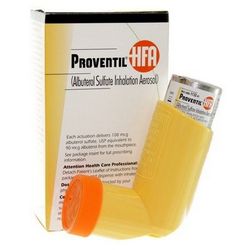Proventil Inhaler
Proventil is a bronchodilator drug that is used for the relief and prevention of asthma attacks. The main active ingredient is salbutamol. The drug is produced in the form of an inhalation solution, in an aerosol. 1 aerosol contains 200 doses of the drug, and 1 dose contains 100 mcg of salbutamol.
How does it work?
This drug belongs to the group of expectorant pharmaceuticals that are used to treat respiratory diseases.
Salbutamol is a beta-2 adrenergic agonist. It has the ability to stimulate β-two adrenergic receptors. The latter have the property to have a noticeable bronchodilator effect, focusing on the blood vessels of the bronchi and expanding the bronchi.
It has an invaluable property to prevent and interrupt arising bronchospasm. It is able to reduce the resistance that occurs in the respiratory tract, while the vital capacity of the lungs increases.
Salbutamol reduces the release of histamines, contributes to the expansion of the coronary arteries of the circulatory system, while lowering blood pressure is not observed.
The drug as a whole has the property of facilitating the work of the lower parts of the respiratory system – the lungs and bronchi.
Indications for use
- Relief and prevention of asthma attack in bronchial asthma;
- Сhronic bronchitis and emphysema;
- Obstructive syndrome in children;
- Bronchospasm of different origin;
- Prevention of an asthma attack associated with physical exertion or possible contact with allergens.
Dosage and instructions for use
Proventil is used by inhalation.
Use the drug as recommended by a doctor!
- Adults and children over 4 years of age: in acute bronchospasm – 1 – 2 inhaled doses (the next dose is not earlier than 4 hours). Prevention of suffocation seizures due to exertion – 2 doses before exercise. Prevention before possible contact with the anticipated allergen – 1 dose in 10-15 minutes inhalation;
- With prolonged use of Proventil: 1-2 inhalations 3-4 times a day with an interval of at least 3 hours. Do not use more than 8 doses per day;
- Children over 2 years of age: relief of asthma attacks – 1 inhalation once, systemic therapy – 1 inhalation 3-4 times a day.
In order for the drug to get into the respiratory throat during inhalation, you need to:
- shake the spray can;
- exhale as much as possible air from the lungs;
- insert an aerosol mouthpiece into your mouth, clasping it with your lips on all sides;
- clicking on the bottom of the can, take a deep breath;
- hold your breath for as long as possible.
1 dose is sufficient for most patients. The relief comes in about 5 minutes.
Overdose
Symptoms: trembling, tachycardia, mental stress, headache, low blood pressure. The treatment is symptomatic. There is no specific antidote.
Side effects
In some cases, Proventil can cause the following side effects:
- anxiety;
- tremor (usually brushes);
- tension;
- dizziness;
- irritability;
- sleep disturbances;
- headache;
- an increase in blood levels of glucose, free fatty acids;
- dose-dependent hypokalemia;
- short-term convulsions;
- tachycardia;
- heartbeat;
- arrhythmia;
- loss of appetite;
- pharyngitis;
- bronchospasm (caused by hypersensitivity to salbutamol);
- increase or decrease in blood pressure;
- peripheral vasodilation;
- heart failure;
- myocardial ischemia;
- cardiopathy;
- nausea;
- irritation or dryness in the mouth or throat;
- vomiting;
- sweating;
- difficulty urinating;
- mental and physical drug dependence;
- allergic reactions such as facial swelling, erythema, shortness of breath.
If you experience any disturbing side effects after using Proventil, contact your doctor.
Pregnancy and lactation
During pregnancy, Proventil inhaler can be used only for health reasons. Since salbutamol passes into breast milk, its use during lactation is possible only in this case when the expected therapeutic effect for the mother outweighs the potential risk to the baby.
Interaction with other drugs
Salbutamol should not be used with non-selective beta-blockers (including topical eye products that contain beta-blockers). The concurrent use of cardioselective beta-blockers does not reduce the effect of salbutamol.
Simultaneous treatment with xanthine derivatives, diuretics and corticosteroids can contribute to severe hypokalemia.
Also, you cannot use general anesthetics, tricyclic antidepressants and maprotiline, ergotamine and MAO inhibitors together with salbutamol.
When salbutamol is used with cardiac glycosides, it increases the risk of arrhythmia due to hypokalemia.
Special instructions
It is recommended to monitor the level of potassium in the blood, especially in case of severe bronchial asthma.
The drug should be used with caution in patients who have hypersensitivity to salbutamol, thyrotoxicosis, serious cardiovascular diseases (coronary heart disease, angina pectoris, arrhythmia), arterial hypertension, diabetes, pheochromocytoma and ketoacidosis.
When using the inhaler, it is necessary to protect the eyes from the ingress of aerosol particles.
The use of salbutamol in high doses can worsen the reaction when driving or working with machinery. This action is enhanced with the simultaneous use of alcohol, tranquilizers.
